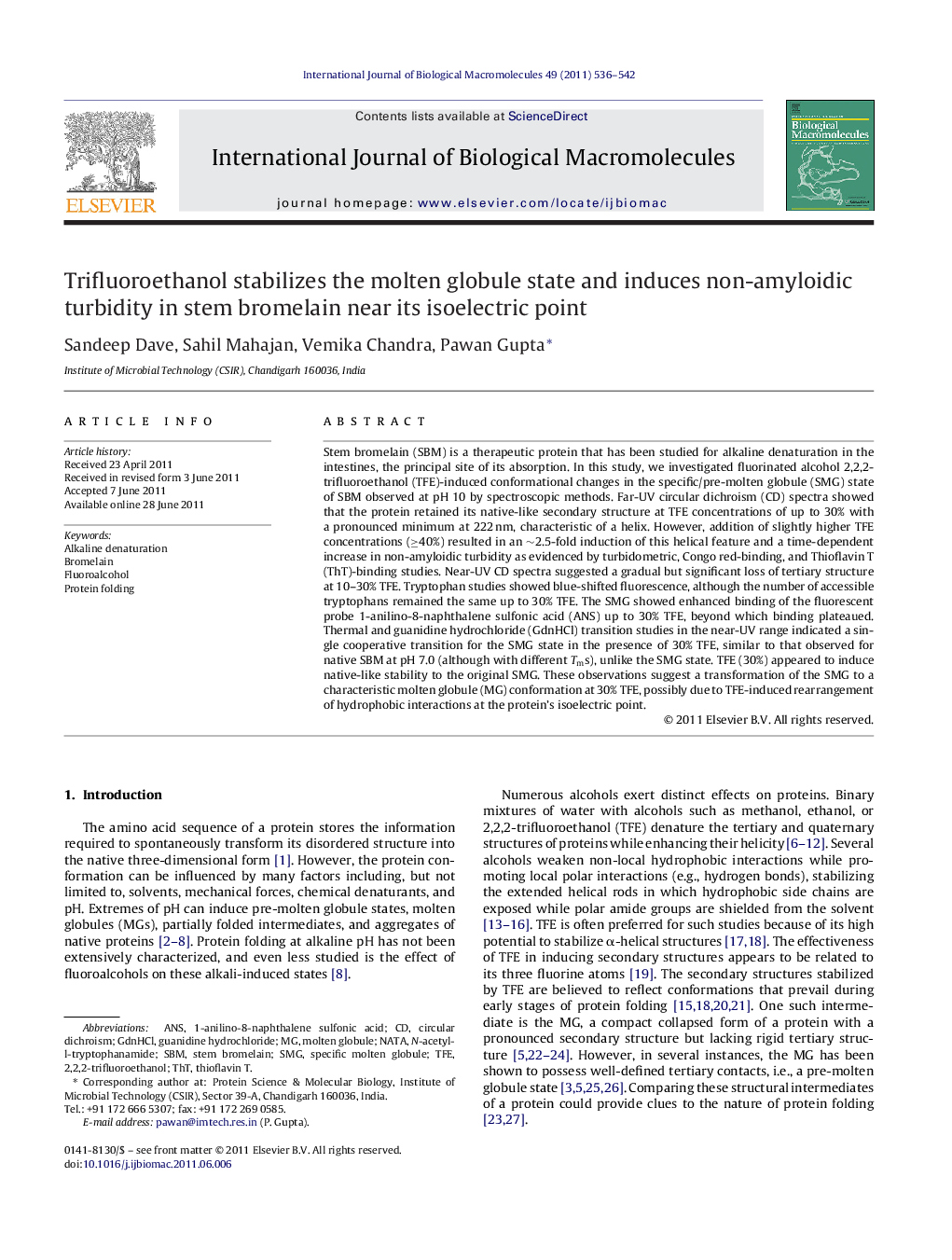| کد مقاله | کد نشریه | سال انتشار | مقاله انگلیسی | نسخه تمام متن |
|---|---|---|---|---|
| 8335420 | 1540279 | 2011 | 7 صفحه PDF | دانلود رایگان |
عنوان انگلیسی مقاله ISI
Trifluoroethanol stabilizes the molten globule state and induces non-amyloidic turbidity in stem bromelain near its isoelectric point
دانلود مقاله + سفارش ترجمه
دانلود مقاله ISI انگلیسی
رایگان برای ایرانیان
کلمات کلیدی
SMG1-anilino-8-naphthalene sulfonic acidAlkaline denaturationN-acetyl-L-tryptophanamideGdnHClSBMTFENATA2,2,2-trifluoroethanol - 2،2،2-trifluoroethanolBromelain - بروملینThT - بلهProtein folding - تاشدگی پروتئینThioflavin T - تیوفلاوین Tcircular dichroism - رنگ تابی دورانیStem bromelain - ساقه برملائینANS - سالFluoroalcohol - فلورا الکلMolten globule - گلوله گلولهGuanidine hydrochloride - گوانیدین هیدروکلراید
موضوعات مرتبط
علوم زیستی و بیوفناوری
بیوشیمی، ژنتیک و زیست شناسی مولکولی
زیست شیمی
پیش نمایش صفحه اول مقاله

چکیده انگلیسی
Stem bromelain (SBM) is a therapeutic protein that has been studied for alkaline denaturation in the intestines, the principal site of its absorption. In this study, we investigated fluorinated alcohol 2,2,2-trifluoroethanol (TFE)-induced conformational changes in the specific/pre-molten globule (SMG) state of SBM observed at pH 10 by spectroscopic methods. Far-UV circular dichroism (CD) spectra showed that the protein retained its native-like secondary structure at TFE concentrations of up to 30% with a pronounced minimum at 222 nm, characteristic of a helix. However, addition of slightly higher TFE concentrations (â¥40%) resulted in an â¼2.5-fold induction of this helical feature and a time-dependent increase in non-amyloidic turbidity as evidenced by turbidometric, Congo red-binding, and Thioflavin T (ThT)-binding studies. Near-UV CD spectra suggested a gradual but significant loss of tertiary structure at 10-30% TFE. Tryptophan studies showed blue-shifted fluorescence, although the number of accessible tryptophans remained the same up to 30% TFE. The SMG showed enhanced binding of the fluorescent probe 1-anilino-8-naphthalene sulfonic acid (ANS) up to 30% TFE, beyond which binding plateaued. Thermal and guanidine hydrochloride (GdnHCl) transition studies in the near-UV range indicated a single cooperative transition for the SMG state in the presence of 30% TFE, similar to that observed for native SBM at pH 7.0 (although with different Tms), unlike the SMG state. TFE (30%) appeared to induce native-like stability to the original SMG. These observations suggest a transformation of the SMG to a characteristic molten globule (MG) conformation at 30% TFE, possibly due to TFE-induced rearrangement of hydrophobic interactions at the protein's isoelectric point.
ناشر
Database: Elsevier - ScienceDirect (ساینس دایرکت)
Journal: International Journal of Biological Macromolecules - Volume 49, Issue 4, 1 November 2011, Pages 536-542
Journal: International Journal of Biological Macromolecules - Volume 49, Issue 4, 1 November 2011, Pages 536-542
نویسندگان
Sandeep Dave, Sahil Mahajan, Vemika Chandra, Pawan Gupta,